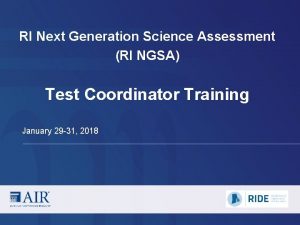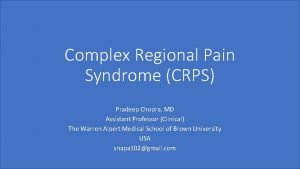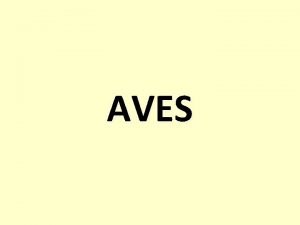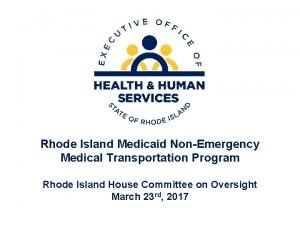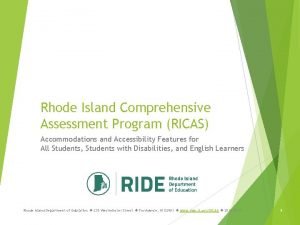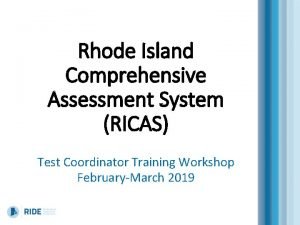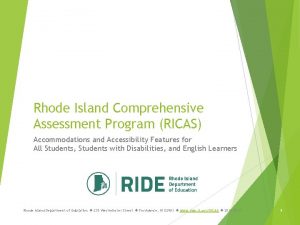Rhode Island Nursing Facility Payment Methodology Status Update













- Slides: 13

Rhode Island Nursing Facility Payment Methodology: Status Update March 15, 2012

Agenda n Overview of Base Methodology n Options for Transition n Recognition of Quality and Dementia

EOHHS Nursing Home Rate Method Objectives n Budget Neutrality n Pay Higher Rates for Higher Acuity q q Implementation of an Acuity Adjustment for Nursing Homes, July 2010 reimburse homes based on each patient's specific RUG category n Payment method that ensures ease of administration and predictability n Transition from a facility specific cost based system to a price based model similar to Medicare PPS

Base Rate Per Diem Components: Direct Care Direct Nursing: $97. 99 Other Direct Care: $23. 16 Total: $121. 15 n n n (101. 54% of the day-weighted median costs) (100. % of the day-weighted median costs) Indirect Care (incl. utilities & insurance) $52. 22 n (93. 48% of the day-weighted median costs) Fair Rental Value (FRV) Five quintile rates based on the weighted average of individual rates within each grouping. The range within each quintile is $2. ) n q $12. 37, $14. 03, $15. 65, $18. 00, $20. 00 Property Taxes Eight rate groups based on the weighted average of the individual rates within each group. The range within each group is $1. n q $0. 00, $0. 76, $1. 73, $2. 47, $3. 47, $4. 42, $5. 17, $6. 53 Provider Assessment n An add-on equal to 5. 82% of the sum of the above components.

Base Rate Per Diem Components: Acuity Factor n q q n Based on the patient specific RUG category, i. e. one of 48 RUG weights. Acuity factor to be applied only to the $97. 99 Direct Nursing Base Rate Market Basket Increase

Hybrid Model n n n maintains facility-specific cost-based reimbursement plus a small incentive payment if costs are less than the ceiling incentive payment is 10% of the difference between the facility's cost and the ceiling, with a maximum incentive payment of $5 in each cost center the ceiling in direct care is 107. 55% of median cost while in indirect care, it is 99. 15% of the median.

Underlying Assumptions n Each facility’s casemix and Medicaid volume will remain stable over the transition period n No inflation factors have been applied n To make the new payment method budget neutral, the Direct Care component was increased slightly.

Impact of Base Methodology n Avoid dramatic gains and losses that individual providers will incur 40 homes would lose 19 homes lose $10 -$20 per day q 3 homes lose more than $20 per day q n 44 homes would gain 17 homes gain $10 -$20 per day q 4 homes gain more than $20 per day q

Transition Approaches n Payment methodology to be phased in over three years. q Direct and Indirect Care n n n q Year 1: 67% facility specific / 33% price based; Year 2: 33% facility specific / 67% price based; Year 3: 100% price based FRV and Taxes: n Year 1: 100% price-based groupings

Transition Approaches Policy Adjustor - No home loses more than $5. 00 - No home gains more than $5. 00 - Maintains existing direct care costs

Transition Approaches

Recognition of Quality and Dementia n Need to agree on basic approach first n 2 -3 meetings in April – early May

Discussion n Next steps
 Rhode island business development
Rhode island business development Ngsa testing
Ngsa testing Rhode island board of governors for higher education
Rhode island board of governors for higher education Interesting facts rhode island
Interesting facts rhode island Pradeep chopra md
Pradeep chopra md Galinha rhode island red
Galinha rhode island red Does logisticare pay weekly or biweekly
Does logisticare pay weekly or biweekly Rigl §44-30-12(c)(8)
Rigl §44-30-12(c)(8) Rhode island environmental police
Rhode island environmental police Ricas english language arts
Ricas english language arts Stem cell therapy rhode island
Stem cell therapy rhode island Ricas practice test
Ricas practice test Ricas math reference sheet
Ricas math reference sheet Rhode island comprehensive assessments system
Rhode island comprehensive assessments system

